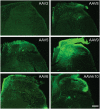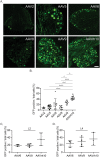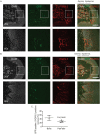Adeno-associated virus serotype rh10 is a useful gene transfer vector for sensory nerves that innervate bone in immunodeficient mice
- PMID: 29233995
- PMCID: PMC5727257
- DOI: 10.1038/s41598-017-17393-z
Adeno-associated virus serotype rh10 is a useful gene transfer vector for sensory nerves that innervate bone in immunodeficient mice
Abstract
Adeno-associated virus (AAV) is frequently used to manipulate gene expression in the sensory nervous system for the study of pain mechanisms. Although some serotypes of AAV are known to have nerve tropism, whether AAV can distribute to sensory nerves that innervate the bone or skeletal tissue has not been shown. This information is crucial, since bone pain, including cancer-induced bone pain, is an area of high importance in pain biology. In this study, we found that AAVrh10 transduces neurons in the spinal cord and dorsal root ganglia of immunodeficient mice with higher efficacy than AAV2, 5, 6, 8, and 9 when injected intrathecally. Additionally, AAVrh10 has tropism towards sensory neurons in skeletal tissue, such as bone marrow and periosteum, while it occasionally reaches the sensory nerve fibers in the mouse footpad. Moreover, AAVrh10 has higher tropic affinity to large myelinated and small peptidergic sensory neurons that innervate bone, compared to small non-peptidergic sensory neurons that rarely innervate bone. Taken together, these results suggest that AAVrh10 is a useful gene delivery vector to target the sensory nerves innervating bone. This finding may lead to a greater understanding of the molecular mechanisms of chronic bone pain and cancer-induced bone pain.
Conflict of interest statement
The authors declare that they have no competing interests.
Figures






Similar articles
-
Adeno-associated Virus Vectors Efficiently Transduce Mouse and Rabbit Sensory Neurons Coinfected with Herpes Simplex Virus 1 following Peripheral Inoculation.J Virol. 2016 Aug 12;90(17):7894-901. doi: 10.1128/JVI.01028-16. Print 2016 Sep 1. J Virol. 2016. PMID: 27334582 Free PMC article.
-
Transduction efficiency of neurons and glial cells by AAV-1, -5, -9, -rh10 and -hu11 serotypes in rat spinal cord following contusion injury.Gene Ther. 2014 Dec;21(12):991-1000. doi: 10.1038/gt.2014.74. Epub 2014 Aug 14. Gene Ther. 2014. PMID: 25119378
-
Differential adeno-associated virus mediated gene transfer to sensory neurons following intrathecal delivery by direct lumbar puncture.Mol Pain. 2010 May 28;6:31. doi: 10.1186/1744-8069-6-31. Mol Pain. 2010. PMID: 20509925 Free PMC article.
-
The Physiology of Bone Pain. How Much Do We Really Know?Front Physiol. 2016 Apr 26;7:157. doi: 10.3389/fphys.2016.00157. eCollection 2016. Front Physiol. 2016. PMID: 27199772 Free PMC article. Review.
-
Crosstalk Between Sensory Nerves and Cancer in Bone.Curr Osteoporos Rep. 2018 Dec;16(6):648-656. doi: 10.1007/s11914-018-0489-x. Curr Osteoporos Rep. 2018. PMID: 30343404 Review.
Cited by
-
Crosstalk between bone metastatic cancer cells and sensory nerves in bone metastatic progression.Life Sci Alliance. 2024 Sep 12;7(12):e202302041. doi: 10.26508/lsa.202302041. Print 2024 Dec. Life Sci Alliance. 2024. PMID: 39266299 Free PMC article.
-
Characterization of commercially available murine fibrosarcoma NCTC-2472 cells both in vitro and as a model of bone cancer pain in vivo.PLoS One. 2024 Aug 29;19(8):e0309398. doi: 10.1371/journal.pone.0309398. eCollection 2024. PLoS One. 2024. PMID: 39208033 Free PMC article.
-
Osteoblasts derived from mouse mandible enhance tumor growth of prostate cancer more than osteoblasts derived from long bone.J Bone Oncol. 2020 Dec 30;26:100346. doi: 10.1016/j.jbo.2020.100346. eCollection 2021 Feb. J Bone Oncol. 2020. PMID: 33425674 Free PMC article.
References
Publication types
MeSH terms
Substances
Grants and funding
LinkOut - more resources
Full Text Sources
Other Literature Sources

